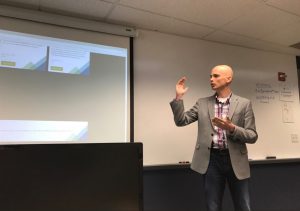Dell Technologies World 2018 took place in Las Vegas earlier this month and Arraya was there to take in the sights and sounds. Our team returned to Arraya HQ with plenty of insights regarding what’s here and what’s coming next from the Dell Technologies family, including our strategic partners Dell EMC and VMware.
of insights regarding what’s here and what’s coming next from the Dell Technologies family, including our strategic partners Dell EMC and VMware.
Here’s a recap of the biggest data center stories they encountered during their stay in the desert – and what they could mean for you.
Introducing the latest PowerEdge Servers
Dell Technologies pulled the tarp off a pair of new additions to its PowerEdge server line – the R840 and the R940xa. There’s plenty of alphabet soup to explain the possible impact of these servers. Example: R940xa promises a 1:1 CPU to GPU ratio while the R840 can support up to 24 direct-attach NVMe drives.
More simply, the R940xa and the R840 are each meant for a specific use case. The R940xa can handle graphics and compute-heavy workloads, enabling real time, GPU-related decision-making. Meanwhile, the R840 supports faster, more capable analytics and machine-learning workloads. If either of those scenarios sounds like your data center, these servers could make sense for you.
The R940xa and the R840 both hit the market on May 22.
Enhancing the onramp to SDDC
Much of the Dell Technologies World news fits the bill of “revolutionary.” Others are more “evolutionary.” The changes announced to VxRail and VxRack fit into that latter category but are no less meaningful because of it. By making these adjustments to its line of hyperconverged infrastructure solutions, Dell EMC is providing customers a robust and modern architecture around which to construct their software-defined data center (SDDC).
Perhaps the most noteworthy element of the latest VxRack is its support of the 14th generation of Dell EMC PowerEdge servers. This type of compatibility has existed for some time for organizations looking to build and maintain their own data center environment by way of vSphere or VSAN ReadyNodes. However, this marks the first time that this server family will be available through VxRack configurations. Co-developed with VMware, these technologies mark a fast, reliable route for those who want to create a multi-cloud or SDDC environment.
VxRack SDDC also includes the following developments:
- Enhanced configurations with the availability of 14th Generation PowerEdge Servers
- VDI enhancements via support for NVIDIA GPUs
- IT-as-a-Service (IaaS) capabilities leveraging the latest VMware Cloud Foundation release
Meanwhile, VxRail nodes, leveraging Dell’s 14G PowerEdge Servers, now include support for the following:
- NVMe cache devices – think higher performance and lower latency than SAS cache devices
- Increased memory – up to 3 TB per node
- NVIDIA Tesla P40 GPUs – 2x performance and 50% increased user support for high-end end0user compute use cases
The latest versions of Dell EMC VxRail and VxRack appliances are available now.
Redefining and renaming VMAX
VMAX, Dell EMC’s enterprise-grade, all-flash storage system, has undergone quite the transformation of late, including leaving Dell Technologies World with a new name: PowerMax. Dell EMC has redesigned PowerMax to make it the fastest storage solution on the market. PowerMax’s blazing speed stems from its ability for total NVMe device support end-to-end. Architected with full NVMe support leveraging NVMe-over-Fabrics, PowerMax can realize end-to-end NVMe support within a data center. This should prove appealing to enterprises continuing to leverage external storage arrays that need very-high performance and very-low latency levels.
Additionally, PowerMax can support organizations transitioning into more cutting edge, and workload-intensive, disciplines. This includes real-time analytics, IoT, and artificial intelligence. Another buzzy technology with ties to PowerMax is machine learning. The system uses years of data on VMAX performance and lifespans and internal data to boost efficiency and health.
Organizations who see themselves benefitting from this reboot won’t have to wait long. PowerMax arrays are ready to begin shipping ASAP.
Bringing XtremIO to a whole new world
While the latest XtremIO, X2, has been available for almost a year, significant news broke at Dell Technologies World. The newest version of X2 will support native replication with other X2 arrays. Previous generations of XtremIO leveraged RecoverPoint technology to perform data replication. However, the trend both internally at Dell EMC and among its competitors has been to deliver these capabilities natively. Dell EMC’s own Unity and PowerMax offerings sport this ability, and now the X2 does the same. For customers whose use cases align with what the X2 offers, native replication means one less technology to buy and manage. Reducing environmental complexities and spend are universally appealing upsides.
Furthermore, the entire XtremIO family to date has fallen into the category of enterprise grade storage. That could be starting to change after Dell Technologies World. During the event, it was announced that Dell EMC would offer a new X2 model with the same feature set at a much lower price point, giving an enterprise-grade solution a midmarket budgetary entry point. This can allow growth-focused organizations to invest in a proven storage solution ready to mature alongside their data center.
Next steps: Learn more about the news from Dell Technologies World 2018
Want to learn more about these or any of the other announcements made at this year’s Dell Technologies World? Visit: https://www.arrayasolutions.com//contact-us/. Our experts can help your team determine how these solutions fit into the present – and future – of your data center.
As always, leave us a comment on this or any of our blogs by checking us out on social media. We can be found on LinkedIn, Twitter, and Facebook. Let us know what you think of this post and follow us to stay updated on our industry insights and exclusive IT learning opportunities.
 2016, but like most regulations, it’s been easy to push off until later … well later is now. With just under two weeks to go, it will be difficult to comply with everything if you’re only just beginning the process. If you are playing catch up, below are 5 steps you can take to get on the right track.
2016, but like most regulations, it’s been easy to push off until later … well later is now. With just under two weeks to go, it will be difficult to comply with everything if you’re only just beginning the process. If you are playing catch up, below are 5 steps you can take to get on the right track. Recently, I participated in a leadership session where we reviewed Arraya’s Vision, Mission, Core Values, and Unique Value Proposition (UVP). It’s good to reflect on these occasionally and make sure we are living and working by those statements. While I found the conversations worthwhile, the conversation about UVP in particular struck a chord with me.
Recently, I participated in a leadership session where we reviewed Arraya’s Vision, Mission, Core Values, and Unique Value Proposition (UVP). It’s good to reflect on these occasionally and make sure we are living and working by those statements. While I found the conversations worthwhile, the conversation about UVP in particular struck a chord with me. Knowing how important it is to have the right people, I couldn’t be happier that Arraya has chosen to regularly reward our best of the best, or, as we call them, our Arraya Superheroes. Once a quarter, we shine a spotlight on an employee who has gone above and beyond for our customers. Typically, their picture goes up on a plaque in the lobby, they get their story immortalized in our quarterly company newsletter, and they receive a gift card as a small token of our appreciation for what they do. However, I thought I’d take it a step further and give a shout out to our most recent crop of Arraya Superheroes.
Knowing how important it is to have the right people, I couldn’t be happier that Arraya has chosen to regularly reward our best of the best, or, as we call them, our Arraya Superheroes. Once a quarter, we shine a spotlight on an employee who has gone above and beyond for our customers. Typically, their picture goes up on a plaque in the lobby, they get their story immortalized in our quarterly company newsletter, and they receive a gift card as a small token of our appreciation for what they do. However, I thought I’d take it a step further and give a shout out to our most recent crop of Arraya Superheroes. never backs down from a project. Lastly, our first Superhero of 2018 was Dave Brill, one of our Enterprise Architects and someone whose super power is managing a packed calendar without letting our customers down.
never backs down from a project. Lastly, our first Superhero of 2018 was Dave Brill, one of our Enterprise Architects and someone whose super power is managing a packed calendar without letting our customers down. what constitutes a workspace. They’ve called for greater flexibility and the responsibility for delivering that has fallen on IT. Should IT come up short in its attempts to harness digital transformation, it can send users in search of their own solutions, opening the door to dangerous Shadow IT practices. In either case,
what constitutes a workspace. They’ve called for greater flexibility and the responsibility for delivering that has fallen on IT. Should IT come up short in its attempts to harness digital transformation, it can send users in search of their own solutions, opening the door to dangerous Shadow IT practices. In either case,  virtualization, and workspace solutions. Perhaps the event’s most newsworthy moment involved the immediate release of vSphere 6.7, the latest incarnation of VMware’s flagship server virtualization software. Several members of the Arraya Solutions team
virtualization, and workspace solutions. Perhaps the event’s most newsworthy moment involved the immediate release of vSphere 6.7, the latest incarnation of VMware’s flagship server virtualization software. Several members of the Arraya Solutions team  Institute, however, suggests far too many businesses are
Institute, however, suggests far too many businesses are  struggled to make the transition from “wave of the future” to industry standard. However, IPA, a solution that stands at the intersection of automation and artificial intelligence, isn’t lacking in its ability to generate positive business results.
struggled to make the transition from “wave of the future” to industry standard. However, IPA, a solution that stands at the intersection of automation and artificial intelligence, isn’t lacking in its ability to generate positive business results. worry
worry